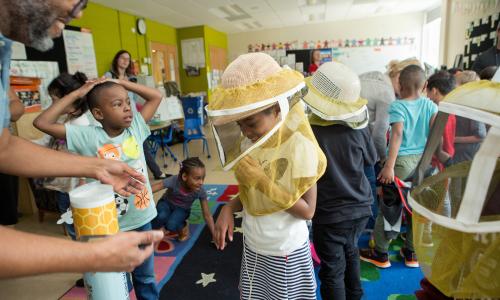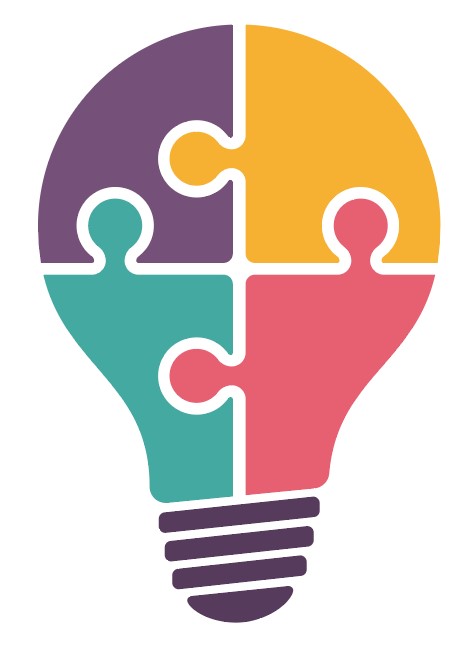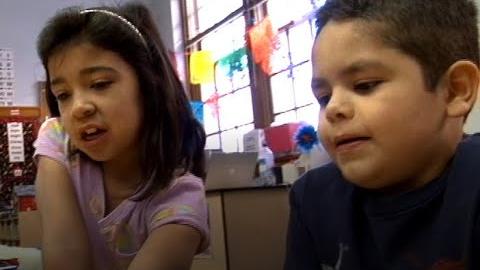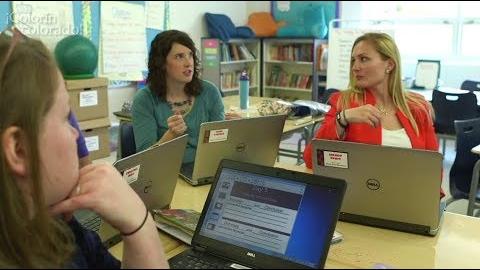Realia and Manipulatives

Realia are any real objects related to the content students are learning. Manipulatives are objects that students interact with, such as blocks, plastic figures, or flash cards. Using these types of hands-on visuals can be effective in supporting content learning. This strategy is part of Colorin Colorado's ELL Strategy Library and can be used to support academic language development for all students.
Professional Learning Resources
See hands-on professional learning materials below, including a slide deck with videos and activities.
Image credit: Photo by Allison Shelley/The Verbatim Agency for EDUimages
Strategy Overview
How This Strategy Supports Language Development
Showing students real objects (realia) in their natural contexts can be a vivid and engaging way to teach vocabulary and build comprehension and background knowledge. For example, a lesson about pollinators might include realia such as a beekeeper suit, like the one pictured above. These items can be brought into the classroom, discovered during actual or virtual museum visits and field trips, or found in the community.
Using realia can also involve all the senses and make concepts more concrete and memorable. For example, seeing a carburetor in an internal combustion engine, comparing different kinds of moss, or holding a replica of an ancient atlatl (spear thrower) cultivates curiosity and establishes comprehensible input.
In addition, manipulating objects like blocks, chips, or cards creates a hands-on path for understanding math, science, language arts, or other content concepts. Manipulating selected objects can make complex concepts more concrete, which is one effective way to scaffold comprehension of grade-level concepts.
Finally, it's important to remember that students can engage with all kinds of hands-on learning activities while developing new language skills. Hands-on activities can be a low-risk, high-reward way for students to show what they know, demonstrate their skills, and feel successful.
Step-by-Step Instructions
- Review the unit or text for key concepts and new vocabulary.
- Determine the realia (real items) or manipulatives that would best support students' comprehension of the key concepts of the unit.
- Locate the realia or create the manipulatives needed for the unit and bring the objects to class.
- Show the objects to the class during the lesson. Label them with vocabulary cards and refer to them throughout the class.
- Choose a routine for students to view the realia or interact with the manipulatives. (See-Think-Wonder and Parts-Purposes-Complexities are two visible thinking routines from Harvard Project Zero that work well with realia.)
- Look for opportunities to use peer learning. For example, partnerships working with manipulatives are effective in building comprehension. Students could take turns explaining why they are interacting with the manipulative (categorizing, sequencing, etc.) in a certain way.
- Ask students to talk about and write about the realia as it applies to the unit or lesson.
- After the experience with the realia or manipulatives, bring the whole group together to review the learning outcomes, check on comprehension, and answer questions that came up during the experience.
Lessons Learned
- Whenever possible, make sure all students (or at the minimum, pairs of students) have a set of manipulatives. As many students as possible should have the opportunity to work with the objects.
- Develop clear, consistent expectations for how students should interact with the realia or manipulatives.
- Give students time to examine and touch the realia, whenever possible.
- If the object is small and inexpensive, give every student one to hold, manipulate, and examine.
- If the realia is fragile (bird’s nest, artifact, etc.), show the real object and provide guidance on how to examine it.
- If students do not respect the objects, put them away and try again at another time.
- Invite parents, instructional coaches, administrators, or other adults into the room when introducing realia or using manipulatives. The extra adults in the room can support content and language development, as well as appropriate use of the materials.
- In order for students to closely view different kinds of realia, consider creating small group stations on the day you introduce the realia. This way, students can get closer to or even touch (if appropriate) the objects.
- Take a picture of the real object for reference after the object is no longer available in the classroom.
- Once students have seen the real object, provide replicas or labeled pictures for them to manipulate and work with throughout the unit.
- Digital realia (videos, pictures, artifacts) work, too, but the videos or pictures should show the actual size and color of the object, so students gain comprehension of the concept or key vocabulary.
Differentiation
- Create small, purposeful groups for rotation stations to view realia or manipulate objects. Guide each group through the observation routine or interaction with the manipulatives so that they develop both language and concepts while at the station.
- Label the parts of the realia or manipulatives in English and students' heritage languages whenever possible. If students are discovering the parts (during the Parts, Purposes, Complexities routine for example), label the parts after the exploratory phase.
- Connect the realia and manipulatives to items from the students' background. Ask students to bring in something from their cultural background that represents the concept, if appropriate.
- When students are working with manipulatives, provide clear written instructions with visual icons for steps they should follow. Include sentence frames and a word bank for them to use while interacting with the manipulatives.
Co-Teaching Considerations
Content or Grade-Level Teacher
- Determine the key concepts students need to know for the unit.
- Determine the language expectations for the lesson/unit. Which words will students need to use to show mastery of the content?
- Collaborate with the ELD teacher to locate realia or make manipulatives for the unit.
English Language Development Teacher
- Suggest realia or manipulatives that could support students in grasping that concept. Bring in some of these items.
- Develop activities for students as they interact with the realia or manipulatives. (See-Think-Wonder and Parts, Purposes, and Complexities are two thinking routines that work well with realia.)
- Show the realia or work with the manipulatives with a small group of entering/emerging level students. Provide heritage language labels and support as necessary.
- Create sentence frames and visual word banks for partnerships as they interact with manipulatives.
Examples
Realia
- Technology from previous eras: typewriter, old fashioned telephone, cassette tape
- Items from nature: abandoned paper wasp nest, animal bones, snake skins, plants, flowers
- Food: root vegetables, exotic fruit, whole spices and herbs
- Clothing that people wear on their jobs: scrubs, firefighter uniform, construction helmet, postal worker uniform
- Household items: spatula, whisk, egg beater
Connecting realia to content
- Plants in a terrarium could support a science lesson on photosynthesis.
- Typewriters and telephones with cords could introduce a unit on technological advancements.
- Pieces of different rock types (igneous, metamorphic, sedimentary) could help students understand the rock cycle.
- Herbs and spices could make a description of food in a novel come to life.
- A circuit board could help explian concepts of electricity.
Manipulatives:
- chips
- beads
- blocks
- flashcards
- sticky notes
- fraction tiles
- plastic figures (like teddy bear counters)
- pictures from a text
- puzzle pieces of a map or other document
Professional Learning Session: Realia and Manipulatives
This Colorín Colorado slide show walks through the Realia and Manipulatives strategy and can be used for turnkey professional development sessions. Please share attribution to Colorín Colorado. For more slide decks, see our Professional Learning Session collection.
To get started, you need:
- Realia and Manipulatives Slide Deck: Includes activities, discussion questions, and speaker's notes (also featured below)
To edit this presentation, you can download or copy the slides:
- File > Download (no Google account required)
- File > Make a copy (Google account required)
Videos: Realia
Albuquerque teacher Ali Nava describes the "realia" activity she used to introduce Burro's Tortillas and some of the items she brought into the classroom for the lesson. The second video showcases a 5th-grade team planning a science lesson about the difference between vascular and non-vascular plants. ESOL specialist Katy Padilla plays a key role in advocating for ELLs throughout the lesson planning process and sharing her strategies for engaging and supporting students.
Resources
- Supporting ELL Success with STEAM and Hands-On Learning (Part 2) (Colorín Colorado)
- Hands-On Activities (Colorín Colorado)
- The Math Manipulatives Hiding in a Junk Drawer (Edutopia)
- See-Think-Wonder Resources, including multilingual materials (Harvard Project Zero)
- 10 fun ways to use realia in your ESL classroom (Bridge Universe)
- Realia: Exploring Texts Through Read Alouds (Learning for Justice)
- Manipulatives in Education (Study.com)
- Video: Parts, Purposes, Complexities, Technology (Project Zero Agency by Design)
- Video: STEM Materials for the Classroom (Pocketful of Primary)
Note: Additional videos are available on subscriber platforms such as Teaching Channel.
References
Bawa, N. and Imam, H. Y. (2020). Realia and Its Relevance in the 21st Century Learning. International Journal of Applied Research and Technology. 9(9): 52 – 56.





